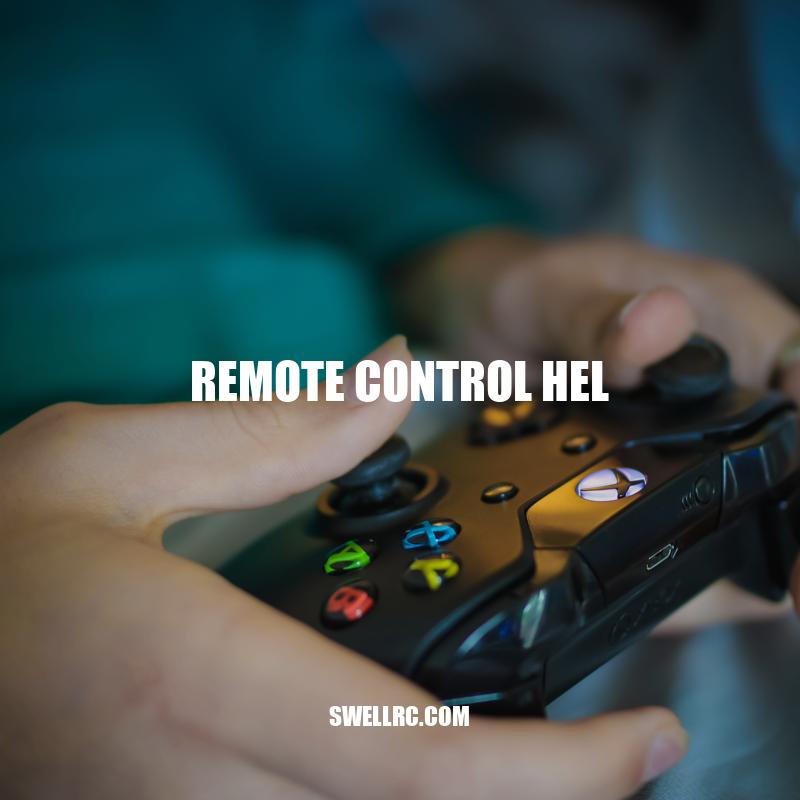Remote Control Helicopters: The Ultimate Guide
Remote control helicopters, also known as RC helis, are becoming increasingly popular among hobbyists and enthusiasts. These miniature aircraft are controlled by a remote and can be flown indoors or outdoors, making them a versatile toy for people of all ages. From beginners to experienced pilots, there is a range of remote control helis available on the market suitable for every skill level. These helicopters come in various shapes, sizes, and types, each with unique features and capabilities. Whether you are looking for a micro heli for indoor flying or a large-scale heli for advanced aerobatics, the options are endless. However, choosing the right remote control heli can be a daunting task, particularly for those unfamiliar with the technology. Each heli has different features and capabilities, making it crucial to consider your skill level, flying environment, and budget before making a purchase. In this article, we will delve into the world of remote control helis and provide tips and advice on how to choose, fly, and maintain your very own RC heli.
Types of Remote Control Helis
There are numerous types of remote control helis available on the market, each with its own unique features and capabilities. Below are some of the most common types of remote control helis:
- Micro helis: These are small and lightweight, perfect for indoor flying and beginners. They are highly affordable and easy to operate. Some popular micro heli brands include Blade and Syma.
- Beginner helis: These are designed for novice pilots and come equipped with easy-to-use controls, auto-stabilization, and durable frames. Popular beginner heli brands include WLtoys and Eachine.
- 3D helis: These are designed for skilled pilots who want to perform aerobatics and stunts in the air. They have powerful motors, high agility, and advanced control systems. Popular 3D heli brands include ALIGN and SAB.
- Large scale helis: These are designed for experienced pilots who want to fly outdoors and perform impressive aerial feats. They have large rotors, high payload capacity, and advanced control systems. Popular large scale heli brands include DJI and Hirobo.
While these are not the only types of remote control helis available, they are some of the most popular varieties. Choosing the right type of heli will depend on your skill level, flying environment, and budget. For further information and to compare different brands and models, many websites offer comprehensive reviews of remote control helis. One such website is RCGroups.com, which features forums dedicated to remote control helicopters and other RC toys.
What are remote control helicopters called?
Remote control helicopters are called multirotor model helicopters. These helicopters are becoming increasingly popular in the hobby and unmanned aerial vehicle (UAV) research industries. They are equipped with electronic control systems and sensors that stabilize the aircraft. For more information, you can check out websites that specialize in RC helicopters or hobby shops that sell these products.
How to Choose a Remote Control Heli
Choosing the right remote control heli can be daunting, given the variety of types and models available in the market. Below are some factors to consider when selecting a remote control heli:
- Skill level: Consider your level of skill and experience with remote control toys. Beginners should select simpler models to learn the basics, while advanced pilots can opt for more advanced models with diverse features.
- Flying Environment: Determine whether you will be flying indoors or outdoors. Indoor helis usually have smaller sizes and lower speed to prevent crashing against walls. Conversely, outdoor helis have a higher payload capacity and stability to tackle variable conditions.
- Size: Check for the size of the heli you want. Generally, larger helis are more stable and better suited for outdoor activities, while smaller ones offer agility but are more suited for indoor activities.
- Cost: Determine your budget as remote control helis can vary significantly in price. Prices range from $20 to thousands of dollars based on size, features, and brand.
Apart from these factors, it is also essential to research different brands and models, and read user and expert reviews before making a purchase. Websites such as Amazon, RC Planet, and Horizon Hobby offer a wide range of models to choose from. The table below provides a brief comparison of some popular remote control heli brands:
| Brand | Special Features | Price Range |
|---|---|---|
| Syma | LED lights, easy-to-use controls, and economical prices | $20-$100 |
| Blade | Stable flight, high-tech features, and easy-to-repair modular design | $100-$500 |
| DJI | Advanced technology, high payload capacity, and HD camera functionality | $800-$5000 |
Keep in mind that different brands offer different features and capabilities, and the right product for you might depend on personal preferences.
Which company is best for remote control helicopter?
The best company for remote control helicopters depend on individual needs such as budget, indoor/outdoor use, battery life, and camera features. However, if we consider the overall best remote control helicopter, SYMA TF1001 is the top choice. For indoor use, we suggest Blade Nano S2 Ultra Micro RC Helicopter while for those who are tight on budget, Cheerwing S107/S107G Phantom is a great option. If you want a remote control helicopter with a camera, Cheerwing U12S Mini RC Helicopter with Camera should satisfy your needs. And lastly, for longer time usage, DEERC DE51 Remote-Control Helicopter offers the best battery life among the top quality brands.
Flying Your Remote Control Heli
Flying a remote control heli can be challenging, especially if you are a beginner. However, with practice and patience, you can quickly master the art of flying a heli. Below are some tips to help you get started:
- Find an open space: Choose a large, open environment, free from obstructions such as trees, buildings, and power lines to avoid accidents.
- Start Slow: Practice with slow speed, and increase it gradually as you build confidence and expertise.
- Do not overcorrect: Overcorrecting by overreacting to minor drifts in motion can destabilize your heli, causing it to crash.
- Manage your throttle: Most remote control helis use dual-stick controllers, with the left stick controlling the throttle and the right stick controlling orientation and spin. Good throttle management is the key to keeping your heli stable in the air.
- Avoid flying your helicopter in windy conditions: Wind can cause unstable flight and increase the risk of crashes.
- Fly in the daylight: It is best to avoid flying at night or in low-light conditions as you may lose sight of your heli and crash.
- Practice, practice, practice: To become an expert user, you must practice flying your remote control heli regularly.
In addition to these tips, you can also look up instructional videos and articles online for more detailed information and guidance. Websites such as YouTube, RC Planet, and Horizon Hobby offer a wealth of resources to help you sharpen your skills.
Another essential aspect of flying your remote control heli is proper maintenance. Check for any damage or wear and tear of the gear and components before each flight, and replace or repair damaged parts immediately. Regular cleaning and lubrication of moving parts also help to extend the life of your heli.
How hard is it to fly a remote control helicopter?
Flying a remote control helicopter is pretty hard for a beginner. It takes time and practice to learn the “ground-up” learning curve before flying it long enough and far away from one’s position. Without proper knowledge and skill, the helicopter may crash within the first 10-20 seconds. For more information, one can refer to RC hobbyist websites or online stores selling beginner-friendly RC helicopters.
Conclusion
In conclusion, remote control helis are a fun and exciting hobby that can bring hours of entertainment to people of all ages. However, it is essential to take the time to research and choose the right model based on your skill level, the environment in which you will be flying, and your budget. Learning to fly a remote control heli may take time and practice, but it’s a rewarding experience that can lead to hours of fun and entertainment. Therefore, it is crucial to follow the safety guidelines and flying tips to avoid accidents and make the most of your investment. With the right equipment, skill, practice, and patience, you can become an expert remote control heli pilot and experience the thrill of flight both indoors and outdoors.



